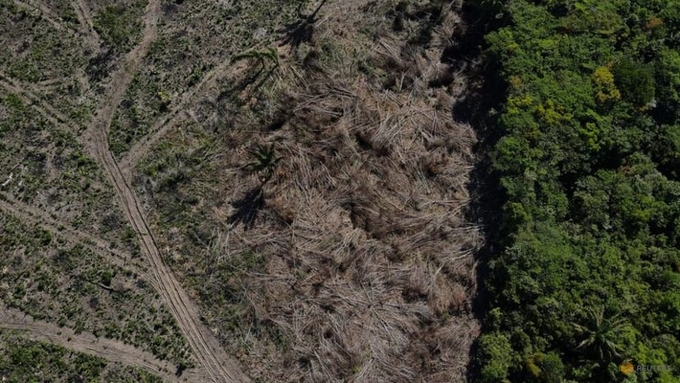November 25, 2025 | 13:01 GMT +7
November 25, 2025 | 13:01 GMT +7
Hotline: 0913.378.918
November 25, 2025 | 13:01 GMT +7
Hotline: 0913.378.918

An aerial view shows a deforested plot of the Amazon rainforest in Manaus, Amazonas State, Brazil July 8, 2022.
This "serious drop … tells us that nature is unravelling and the natural world is emptying", said Andrew Terry, director of conservation and policy at the Zoological Society of London (ZSL).
The World Wildlife Fund (WWF) report, which used 2018 data from ZSL on the status of 32,000 wildlife populations covering more than 5,000 species, found that population sizes had declined by 69 per cent on average. Deforestation, human exploitation, pollution and climate change were the biggest drivers of the loss.
Wildlife populations in Latin America and the Caribbean were hit especially hard, experiencing a 94 per cent drop in just five decades. One population of pink river dolphins in the Brazilian Amazon plummeted by 65 per cent between 1994 and 2016, the report said.
Its findings were broadly similar to those in WWF's last assessment in 2020, with wildlife population sizes continuing to decline at a rate of about 2.5 per cent per year, Terry said.
"Nature was in dire straits and it is still in dire straits," said Mark Wright, director of science at WWF-UK. "The war is definitely being lost."
DESPERATE NEED FOR SUPPORT
However, the report offered some glimmers of hope. While the eastern lowland gorilla population in the Democratic Republic of the Congo's Kahuzi-Biega National Park fell by 80 per cent between 1994 and 2019 due to bushmeat hunting, the mountain gorilla population near Virunga National Park increased from around 400 individuals in 2010 to over 600 by 2018.
Still, the wide-ranging declines have prompted desperate pleas for increased support for nature.
In December, delegates from around the world will gather in Montreal to hash out a new global strategy to protect the world's plants and animals.
One of the biggest asks is likely to be increased financing for global conservation efforts.
"We are calling on the rich nations to provide financial support to us to protect our nature," said Alice Ruhweza, WWF's regional director for Africa.
China needs up to US$17 trillion in additional investments for green infrastructure and technology in the power and transport sectors to reach net-zero emissions by 2060, a new World Bank report on China's climate and development challenges found.
The report, one of a new series of Country Climate and Development Reports, said China - the world's second-largest economy - would need private investment to cover the immense price tag and unleash the needed innovations.
Climate change poses a significant threat to China, especially its densely populated and economically critical low-lying coastal cities, and unabated climate change could cut its economic output by 0.5 per cent to 2.3 per cent as early as 2030, according to the report, which was released on Wednesday (Oct 12).
"China's long-term growth prospects are increasingly dependent on rebalancing the economy from infrastructure investment to innovation, from exports to domestic consumption, and from state-led to market-driven allocation of resources," said Manuela Ferro, the World Bank's vice president for East Asia and the Pacific.
It would also be impossible to reach global climate goals without China transitioning to a low-carbon economy, the report said, noting that China emits 27 per cent of global carbon dioxide and a third of the world's greenhouse gasses.
"This transition will require a massive shift in resources, innovation and new technologies to enhance energy efficiency and resource productivity," the report said.
At the same time, it said China could leverage existing advantages, including higher returns on the production of low-carbon technologies, a high domestic savings rate and a leadership position in green finance.
But it said private-sector participation was "crucial" to ensure China's path to carbon neutrality, and underscored the need for a more predictable regulatory environment and better access to markets and finance.
(Reuters)

(VAN) Brazil's COP30 presidency pushed through a compromise climate deal on Saturday that would boost finance for poor nations coping with global warming but that omitted any mention of the fossil fuels driving it.

(VAN) Poultry farmers in the UK have been warned that they could face one of the worst winters yet for bird flu.

(VAN) Prices of main-crop paddy have risen sharply, with jasmine rice hitting 16,100 baht per tonne — the highest level in years.

(VAN) In Brazil, FAO unveiled a series of reports and initiatives showing how sustainable agrifood systems are a solution to the climate crisis.

(VAN) With names like neodymium and dysprosium, rare-earth elements sound exotic — and their perceived scarcity has only added to the mystique.

(VAN) In a new study published in Trends in Biotechnology, researchers used a gene-editing technology called CRISPR to increase a fungus's production efficiency and cut its production-related environmental impact by as much as 61%- all without adding any foreign DNA.

(VAN) A top official in Beijing’s Cop delegation says China is committed to clean energy – but US’s absence is a problem.